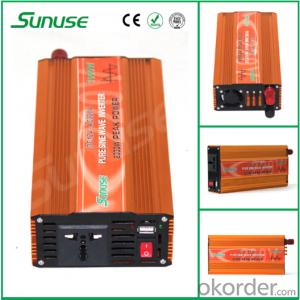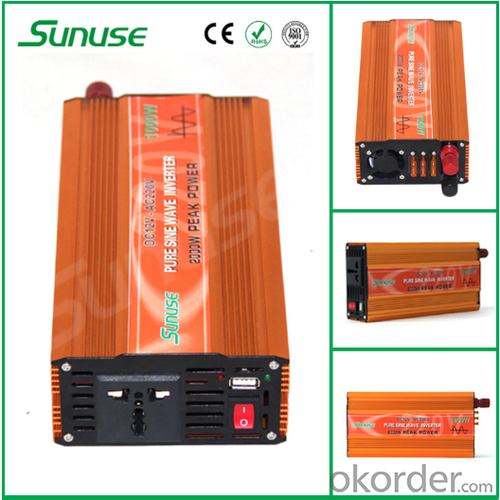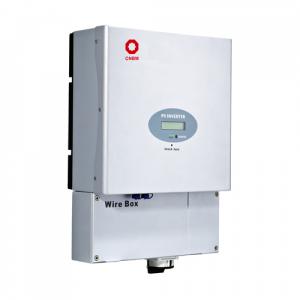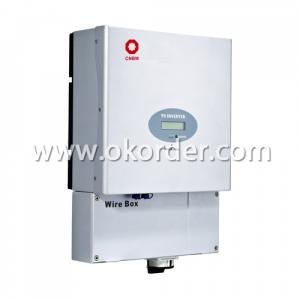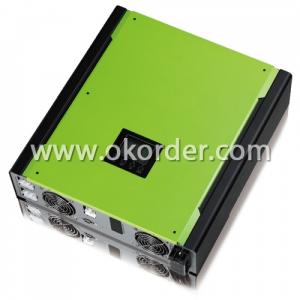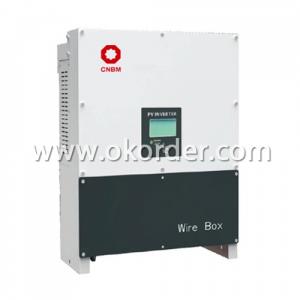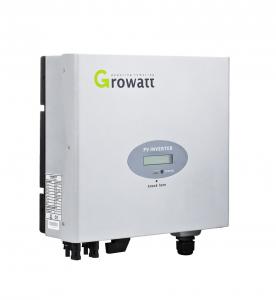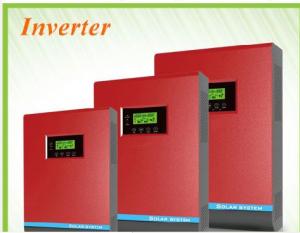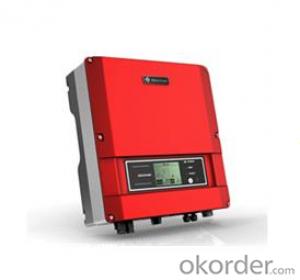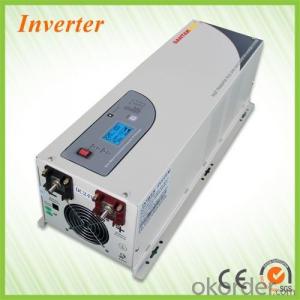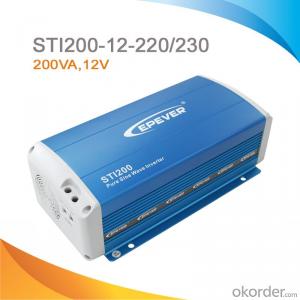Solar Inverter Box:Off Grid 1000W DC 12/24V to AC 110/220V Pure Sine Wave Inverter
- Loading Port:
- Qingdao
- Payment Terms:
- TT OR LC
- Min Order Qty:
- 50000 watt
- Supply Capability:
- 3000000 watt/month
OKorder Service Pledge
OKorder Financial Service
You Might Also Like
1. Structure of Off Grid 1000W DC 12/24V to AC 110/220V Pure Sine Wave Inverter Description
A solar inverter, or PV inverter, or Solar converter, converts the variable direct current (DC) output of a photovoltaic (PV) solar panel into a utility frequency alternating current (AC) that can be fed into a commercial electrical grid or used by a local, off-grid electrical network. It is a critical BOS–component in a photovoltaic system, allowing the use of ordinary AC-powered equipment. Solar inverters have special functions adapted for use with photovoltaic arrays, including maximum power point tracking and anti-islanding protection.
2. Main Features of the Off Grid 1000W DC 12/24V to AC 110/220V Pure Sine Wave Inverter
﹒convert 12V/24V DC to 220V/110V AC to supply for the electronic products such as player MP3, player MP4
﹒DC 12/24V to AC 110/220V
3. Off Grid 1000W DC 12/24V to AC 110/220V Pure Sine Wave Inverter Images
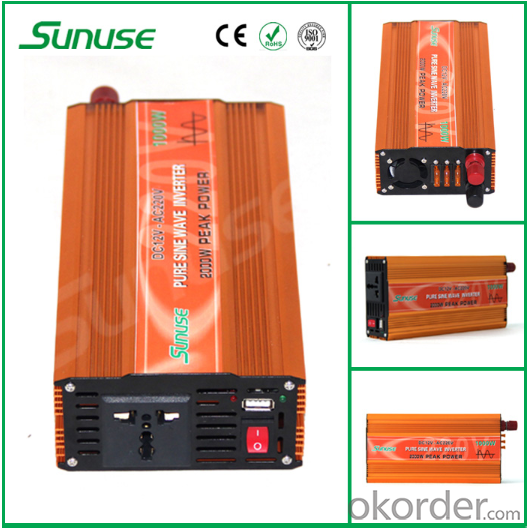
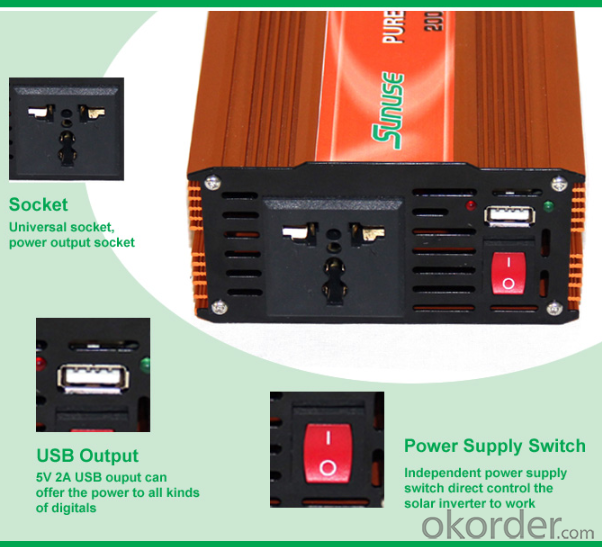
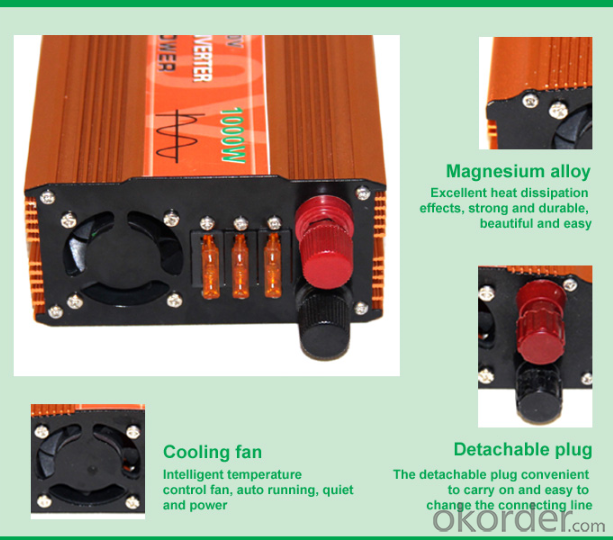
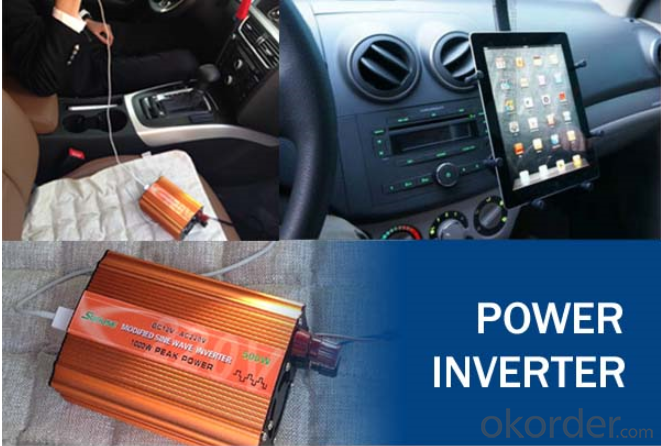
4. Off Grid 1000W DC 12/24V to AC 110/220V Pure Sine Wave Inverter Specification
Specifications: | |||
Type: | 1000W 12V | 1000W 24V | 1000W 48V |
Input DC Voltage Range: | 11-15V DC/22-31V DC/44-62V DC | 11-15V DC/22-31V DC/44-62V DC | 11-15V DC/22-31V DC/44-62V DC |
Under-voltage Protective: | 10.0±0.3V DC/20.0±0.8V DC | 10.0±0.3V DC/20.0±0.8V DC | 10.0±0.3V DC/20.0±0.8V DC |
Under-voltage Alarm: | 10.5±0.3V DC/21.0±0.8V DC | 10.5±0.3V DC/21.0±0.8V DC | 10.5±0.3V DC/21.0±0.8V DC |
Over Voltage Protective: | 16.0±0.3V DC/31.0±0.8V DC | 16.0±0.3V DC/31.0±0.8V DC | 16.0±0.3V DC/31.0±0.8V DC |
Over Voltage Recovery: | 15.0±0.3V DC/29.0±0.8V DC | 15.0±0.3V DC/29.0±0.8V DC | 15.0±0.3V DC/29.0±0.8V DC |
Max Power: | 1000W | ||
Peak Power: | 2000W | ||
USB: | 2000mA | ||
Reverse Protecion: | Blown fuses | ||
Over Load Protection Power: | 110%-120% | ||
Quiescent Current: | ≤0.4A | ||
Max. Efficiency: | ≥92% | ||
Total Harmonic Distortion: | ≤3% Linear load(pure sine wave) | ||
Status Indicator Lamp: | Work: Green LED Failure: Red LED and alarm LED Display: Voltage, Current, Power(optional) | ||
Usage: | for a car, truck, boat, home or standard battery; or solar system, etc. | ||
Work condition: | Operating Temperature: -10~40°C Opetating Humidity: 10--90%(non-condensate) | ||
5. FAQ of Off Grid 1000W DC 12/24V to AC 110/220V Pure Sine Wave Inverter
Q1. What is the difference between inverter and solar inverter?
A1. Inverter only has AC inpput, but solar inverter both connect to AC input and solar panel, it saves more power.
Q2. What is the difference between MPPT&PWM?
A2. MPPT has higher efficiency, it can track the max power point and won't waste energy.
Q3. What is the waranty of product?
A3. 12 months.
- Q: What is the role of a solar inverter in preventing system downtime?
- The role of a solar inverter in preventing system downtime is to efficiently convert the DC power generated by solar panels into AC power that can be used by electrical devices. It ensures the smooth operation of the solar power system by regulating the flow of electricity, monitoring voltage levels, and protecting against potential issues such as overloading or short circuits. By maintaining a stable and reliable power supply, the solar inverter plays a crucial role in minimizing system failures and downtime.
- Q: What is the role of capacitors in a solar inverter?
- The role of capacitors in a solar inverter is to store and release electrical energy in order to regulate and smooth out the flow of power. They help to stabilize the voltage levels, filter out any fluctuations or noise in the electrical signal, and provide a reserve of power for sudden increases in demand. Capacitors also improve the overall efficiency and performance of the solar inverter by reducing the strain on other components and preventing damage from power surges or spikes.
- Q: How does the efficiency of a solar inverter affect the overall system performance?
- The efficiency of a solar inverter plays a crucial role in the overall system performance. A higher efficiency inverter converts a greater percentage of the solar energy into usable electricity, resulting in increased energy production. This means that a more efficient inverter allows the system to generate more power, maximizing the overall performance and output of the solar system. Additionally, a higher efficiency inverter reduces energy losses, which can lead to improved system reliability and cost-effectiveness. Therefore, the efficiency of a solar inverter directly impacts the overall performance and effectiveness of the entire solar energy system.
- Q: Can a solar inverter be easily integrated into an existing electrical system?
- Yes, a solar inverter can be easily integrated into an existing electrical system. It is designed to convert the direct current (DC) power generated by solar panels into alternating current (AC) power that can be used by the electrical system. The inverter can typically be connected to the existing electrical system through a simple installation process, allowing the solar energy to be seamlessly integrated and utilized alongside the conventional power supply.
- Q: How does a solar inverter impact the overall system reliability?
- A solar inverter plays a crucial role in the overall system reliability as it converts the direct current (DC) generated by solar panels into alternating current (AC) that can be used to power household appliances or be fed into the grid. It ensures the reliable and efficient functioning of the entire solar power system by optimizing power output, managing voltage levels, and protecting against various electrical faults. A high-quality solar inverter enhances system performance, improves energy yield, and minimizes downtime, ultimately increasing the overall reliability of the solar power system.
- Q: Are there any noise or vibration concerns associated with solar inverters?
- Yes, there can be noise and vibration concerns associated with solar inverters, although they are generally minimal. Some older or lower-quality inverters may produce a humming or buzzing sound, especially when operating at high power levels. Vibrations can also occur due to the internal components and fans. However, modern inverters are designed to minimize noise and vibrations, and most people find them to be quiet and unobtrusive.
- Q: What is the role of galvanic isolation in a solar inverter?
- The role of galvanic isolation in a solar inverter is to provide electrical safety and protect sensitive electronic components. It prevents the flow of direct current (DC) and alternating current (AC) between the solar panels, the inverter, and the connected electrical system. This isolation helps to eliminate the risk of electrical shocks, voltage surges, and ground faults, ensuring the safe and efficient operation of the solar inverter.
- Q: How does a solar inverter protect against voltage fluctuations?
- A solar inverter protects against voltage fluctuations by continuously monitoring the voltage levels from the solar panels. It adjusts the voltage to match the grid voltage, ensuring a stable and consistent flow of electricity. Additionally, it employs various protective mechanisms such as overvoltage or undervoltage protection, surge protection, and fault detection to safeguard the system from voltage fluctuations and potential damage.
- Q: Can a solar inverter be used in extreme weather conditions?
- Yes, solar inverters are designed to withstand extreme weather conditions. They are built to be durable and resistant to factors such as temperature fluctuations, humidity, and harsh weather elements. However, it is always recommended to consult the manufacturer's guidelines to ensure proper installation and protection measures are in place for specific weather conditions.
- Q: What is the role of a cooling system in a solar inverter?
- The role of a cooling system in a solar inverter is to regulate and dissipate heat generated during the conversion of DC power from solar panels to AC power for use in homes or businesses. By maintaining optimal operating temperatures, the cooling system ensures the inverter's components do not overheat, which could lead to reduced efficiency, performance degradation, or even system failure.
Send your message to us
Solar Inverter Box:Off Grid 1000W DC 12/24V to AC 110/220V Pure Sine Wave Inverter
- Loading Port:
- Qingdao
- Payment Terms:
- TT OR LC
- Min Order Qty:
- 50000 watt
- Supply Capability:
- 3000000 watt/month
OKorder Service Pledge
OKorder Financial Service
Similar products
Hot products
Hot Searches
Related keywords
